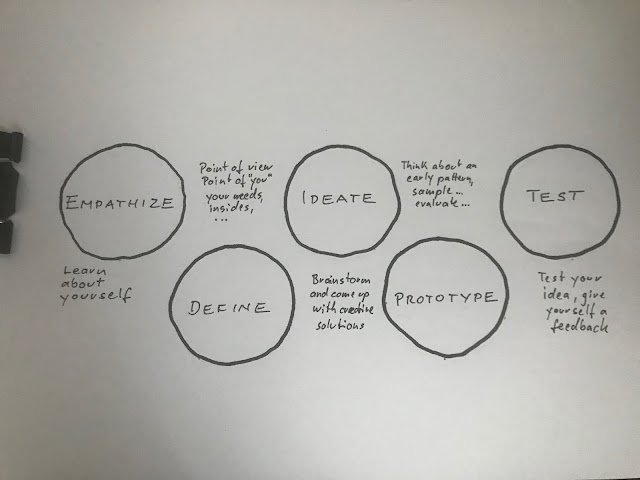Every human being is a designer - design your life by Design Thinking
Since I was a little boy it was without question and beyond doubt for myself and my understanding - that living and designing go together.
Design isn’t just about making things look appealing, or just about usability, or even just delight. It is about taking something from being usable to delightful, and then beyond that — to meaningful.
And I hope that everyone of you agrees that life must cover the same.
Life must be appealing - and only you can define what is appealing for you
Life must be usable - easy to use - reducing hurdles and obstacles, and errors
And most of all life has to be delightful and meaningful to you - and beyond that it is you - your most precious treasure
Remembering the quote by Joseph Beuys ...
… it should remind us to design our life. Even the tools will vary - take the tools you want and need - it might be one time a fineliner, a fine or broad flat brush or even a hammer and pick / chisel … Everyone knows for sure moments in life - like setbacks, failures, loss or other situations and moments of life - when life shows how uncertain life*s ‘roller coaster ride’ can be.
What I want to stress is that every human being is a designer - and life is not a game- or playboard, with a path you have to follow - be creative with your life and enjoy life.
So why not using methods we know from designing products and services? … and design your life!
The crucial point of design is the product and its lifecycle. And as designers, we look at the users, customers and stakeholders - so do the same with yourself. With your life or in challenging moments.
This time ...
… You are the product
… and you are also the designer, user, customer and you are the only or main stakeholder
… your circle of life lists the what, when, and why you do things.
As always, good design builds on understanding the human needs, usage, behavior, motivation, and pain points.
And in the case of ‘designing your life’ I suggest keeping the humans' core beliefs in mind and in balance.
Humans' core beliefs can be summed up in three categories: yourself, others, future and ...
Design isn’t just about making things look appealing, or just about usability, or even just delight. It is about taking something from being usable to delightful, and then beyond that — to meaningful.
And I hope that everyone of you agrees that life must cover the same.
Life must be appealing - and only you can define what is appealing for you
Life must be usable - easy to use - reducing hurdles and obstacles, and errors
And most of all life has to be delightful and meaningful to you - and beyond that it is you - your most precious treasure
Remembering the quote by Joseph Beuys ...
“Every human being is an artist, a freedom being, called to participate in transforming and reshaping the conditions, thinking and structures that shape and inform our lives.” ― Joseph Beuys
… it should remind us to design our life. Even the tools will vary - take the tools you want and need - it might be one time a fineliner, a fine or broad flat brush or even a hammer and pick / chisel … Everyone knows for sure moments in life - like setbacks, failures, loss or other situations and moments of life - when life shows how uncertain life*s ‘roller coaster ride’ can be.
What I want to stress is that every human being is a designer - and life is not a game- or playboard, with a path you have to follow - be creative with your life and enjoy life.
So why not using methods we know from designing products and services? … and design your life!
The crucial point of design is the product and its lifecycle. And as designers, we look at the users, customers and stakeholders - so do the same with yourself. With your life or in challenging moments.
This time ...
… You are the product
… and you are also the designer, user, customer and you are the only or main stakeholder
… your circle of life lists the what, when, and why you do things.
As always, good design builds on understanding the human needs, usage, behavior, motivation, and pain points.
And in the case of ‘designing your life’ I suggest keeping the humans' core beliefs in mind and in balance.
Humans' core beliefs can be summed up in three categories: yourself, others, future and ...
… and your core beliefs are surrounded and accompanied by your behavior, thoughts and feelings.
The five stages of Design Thinking can and will help you
The five stages of Design Thinking are as follows: Empathise, Define (the problem), Ideate, Prototype, and Test. Let’s take a closer look at the five different stages of Design Thinking.

This is an experimental phase, and the aim is to identify the best possible solution for each of your core beliefs and emotions - you have identified during the first three stages.
In this stage of testing, you should obligate yourself to give one or two ideas, which you prototyped or ideas which you could not prototype but still like or want to give a chance, the time to test them.
Something is really important during your testing phase - you should commit yourself to do it for at least 2, 3 or better 4 weeks. If you ask me why - my answer is, because it needs time to establish habits, it takes time to really feel something deep in yourself.
To make something a habit, you need to do it consistently, with self-control, self-mastery or perhaps call it self-restraint (even though I do not like the term restraint or restriction - find a positive term for yourself because whatever you do it should be never a self-chastisement).
But good things don’t come easy, you have to reach out a long way or time, to value them and to really feel them, great things need resilience and repetitions, every sportsman knows that sequences of repetitions, of things we do, knowings things are good, doing things are better but reiterationing and rereiterationing is best.

1. Empathise
The first stage of the Design Thinking process is to gain an empathic understanding. It might sound funny - but do you really understand yourself? Do you know what you want? What motivates you? Empathy is always crucial to a human-centered design process such as Design Thinking, but in the case of ‘designing your life’ - empathy and honesty is super important to gain insight of yourself and your needs.2. Define
During the Define stage, you put together the information you have discovered and gathered during the Empathise stage. This is where you will analyse your ‘discoveries of yourself’ and synthesise them in order to define the your core aims, wishes, challenges and issues.3. Ideate
During the third stage of the Design Thinking process, you should be ready to start generating ideas. You’ve grown to understand yourself and their needs in the Empathise stage, and you’ve analysed and synthesised your observations during the stages before. With this understanding, perhaps discoveries and background, you can start to "think outside the box" to identify new opportunities and you can start to look for alternative ways of viewing challenges and your life. There are hundreds of Ideation techniques such as Brainstorm, Brainwrite, Worst Possible Idea, and YES even thinking about Worst Possible Idea are good to stimulate free thinking and leaving your comfort zone and either discover something you never thought about before or ‘just’ to affirm something what you really don’t like or want. It is important to get as many ideas or alternatives, solutions as possible at the beginning of the Ideation phase. You should pick some other Ideation techniques by the end of the Ideation phase to help you investigate and test your ideas so you can visualize or list the alternatives you have to live or deal with challenges.4. Prototype
I am not sure whether the Prototype stage must be part of your own Design-Thinking process - but for myself I use this phase to check in real on a high-level or by my faculty and power of imagination whether an idea might work or not, how I might feel and behave in a certain situation. Or create a list of pros and cons of each idea you had at the end or during your third stage of ideation.This is an experimental phase, and the aim is to identify the best possible solution for each of your core beliefs and emotions - you have identified during the first three stages.
5. Test
Once you got a good feeling and or the pros are superior over the cons, or the pros outweigh the cons, the advantages outweigh the disadvantages, … you can now decide on which path to choose and give the idea a try.In this stage of testing, you should obligate yourself to give one or two ideas, which you prototyped or ideas which you could not prototype but still like or want to give a chance, the time to test them.
Something is really important during your testing phase - you should commit yourself to do it for at least 2, 3 or better 4 weeks. If you ask me why - my answer is, because it needs time to establish habits, it takes time to really feel something deep in yourself.
To make something a habit, you need to do it consistently, with self-control, self-mastery or perhaps call it self-restraint (even though I do not like the term restraint or restriction - find a positive term for yourself because whatever you do it should be never a self-chastisement).
But good things don’t come easy, you have to reach out a long way or time, to value them and to really feel them, great things need resilience and repetitions, every sportsman knows that sequences of repetitions, of things we do, knowings things are good, doing things are better but reiterationing and rereiterationing is best.






If you like - Please send me your comment, or suggestion you may have. I will not publish the comments. If you want a reply please don't forget to leave your contact information.
ReplyDelete